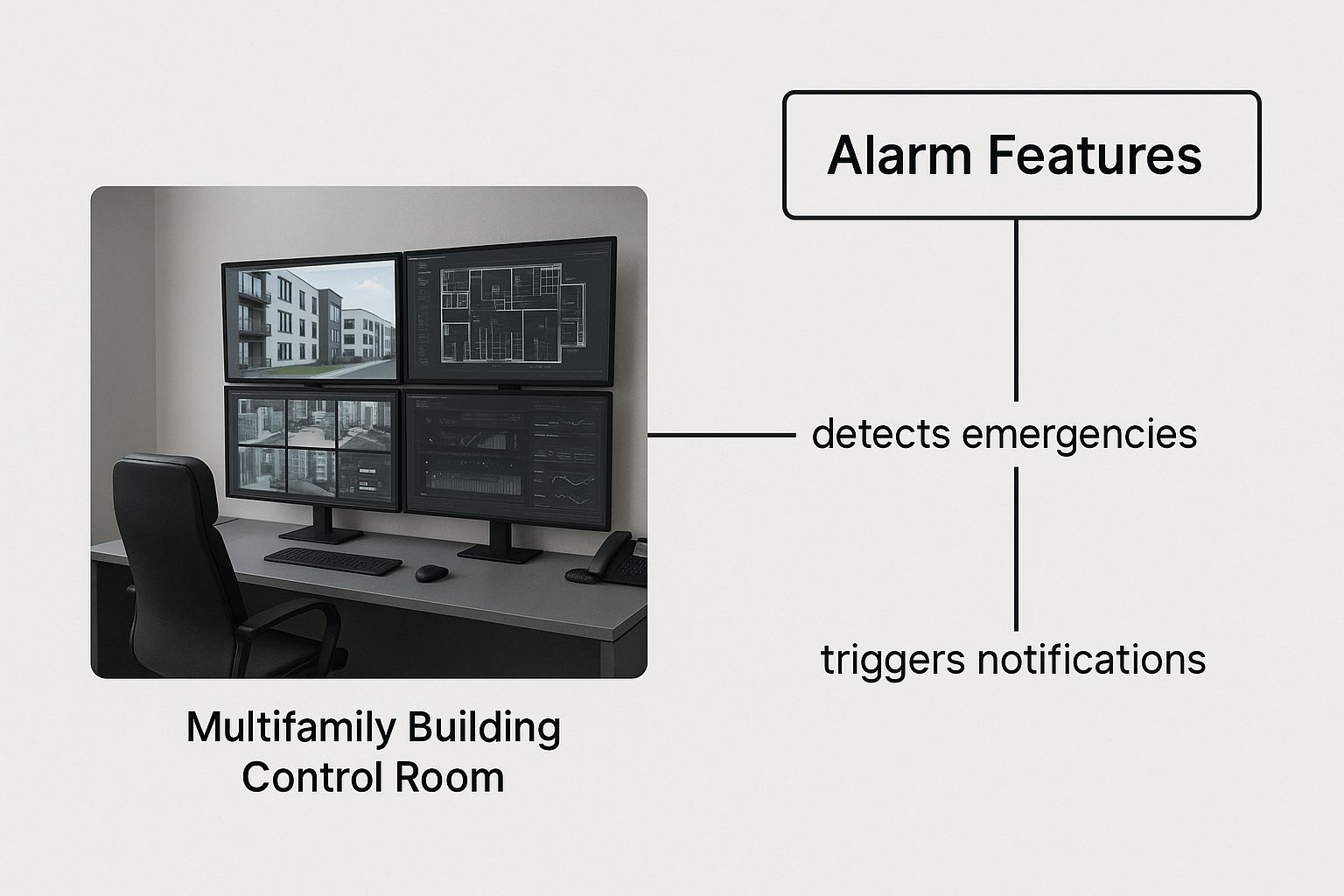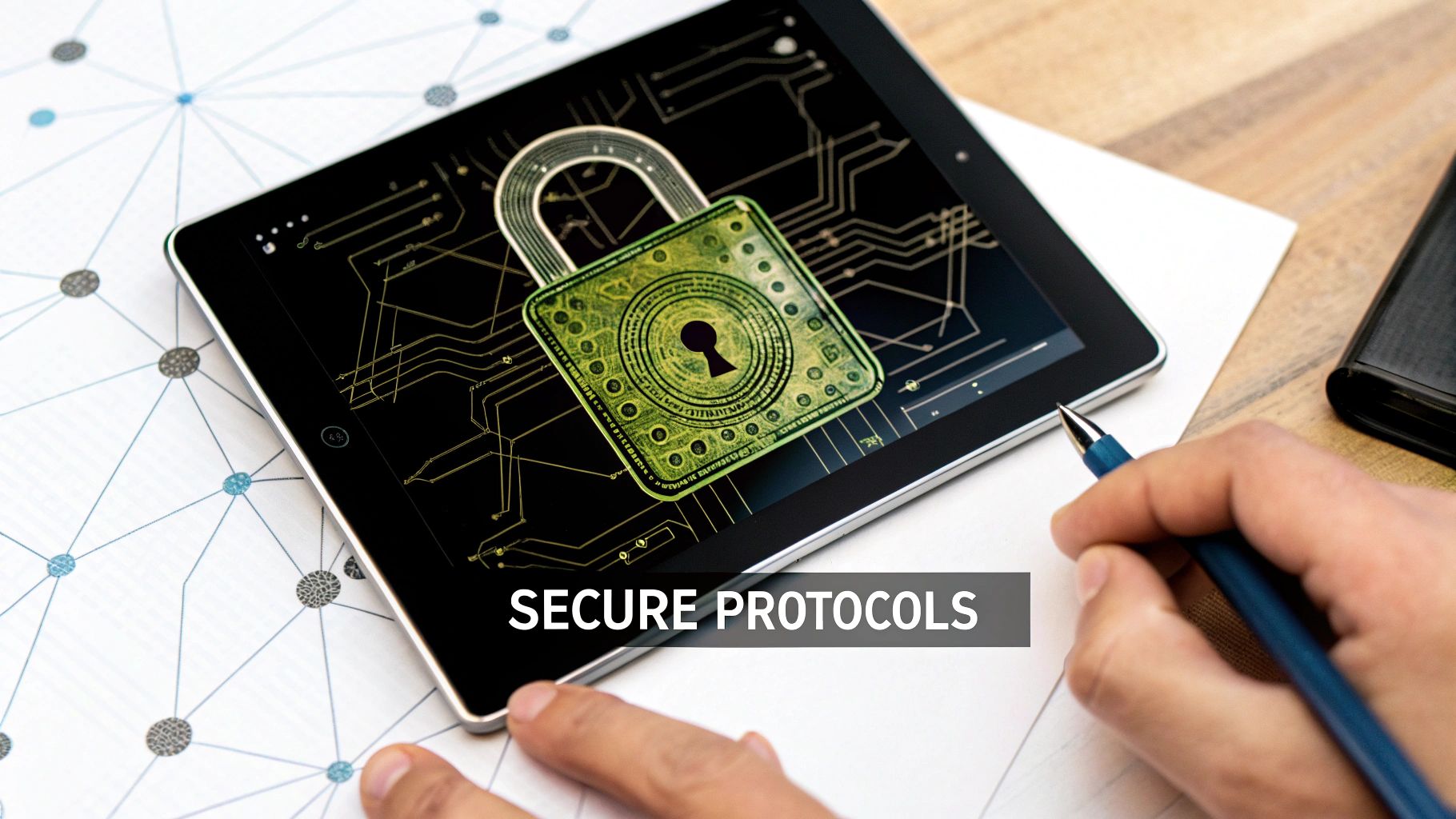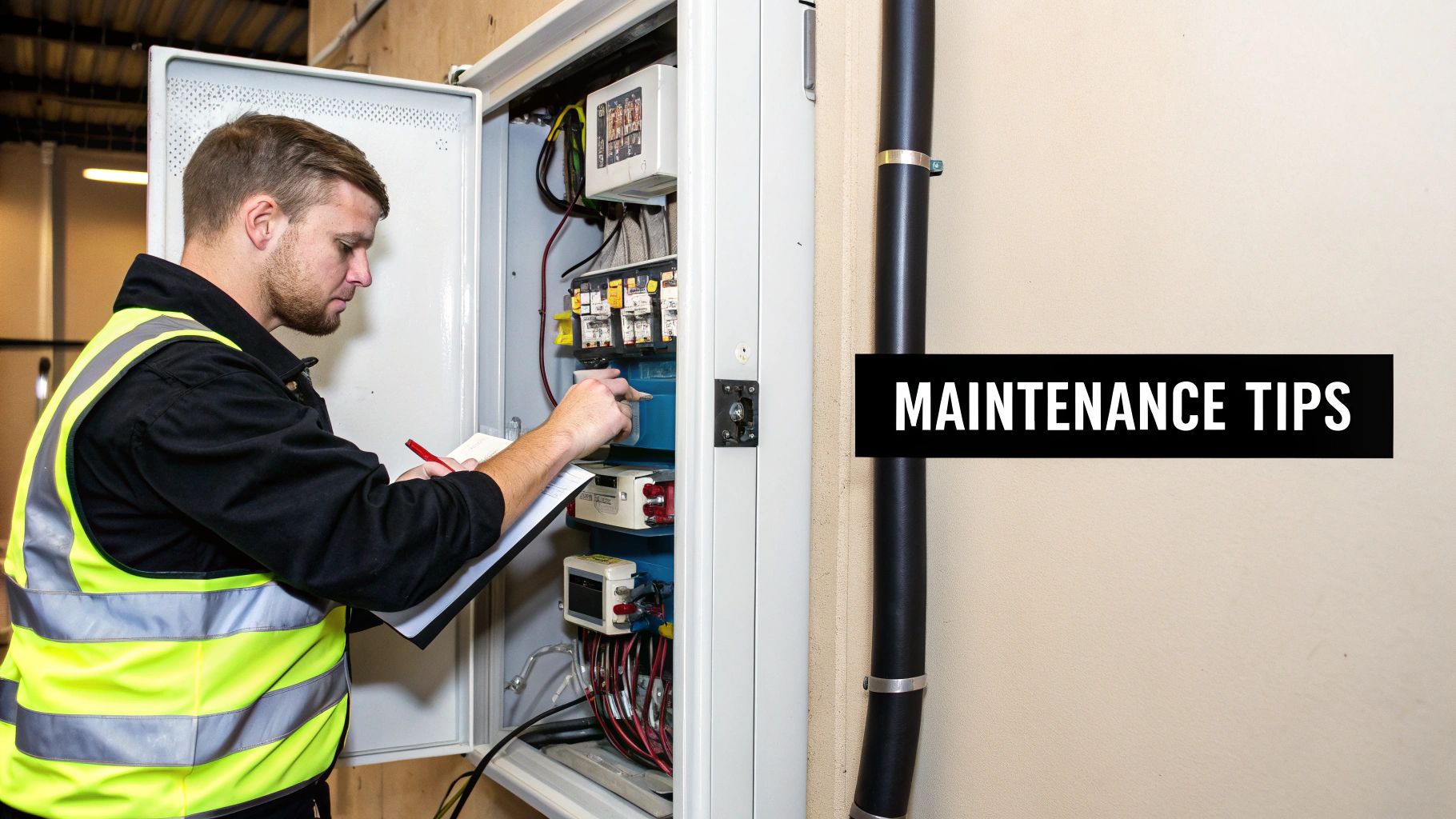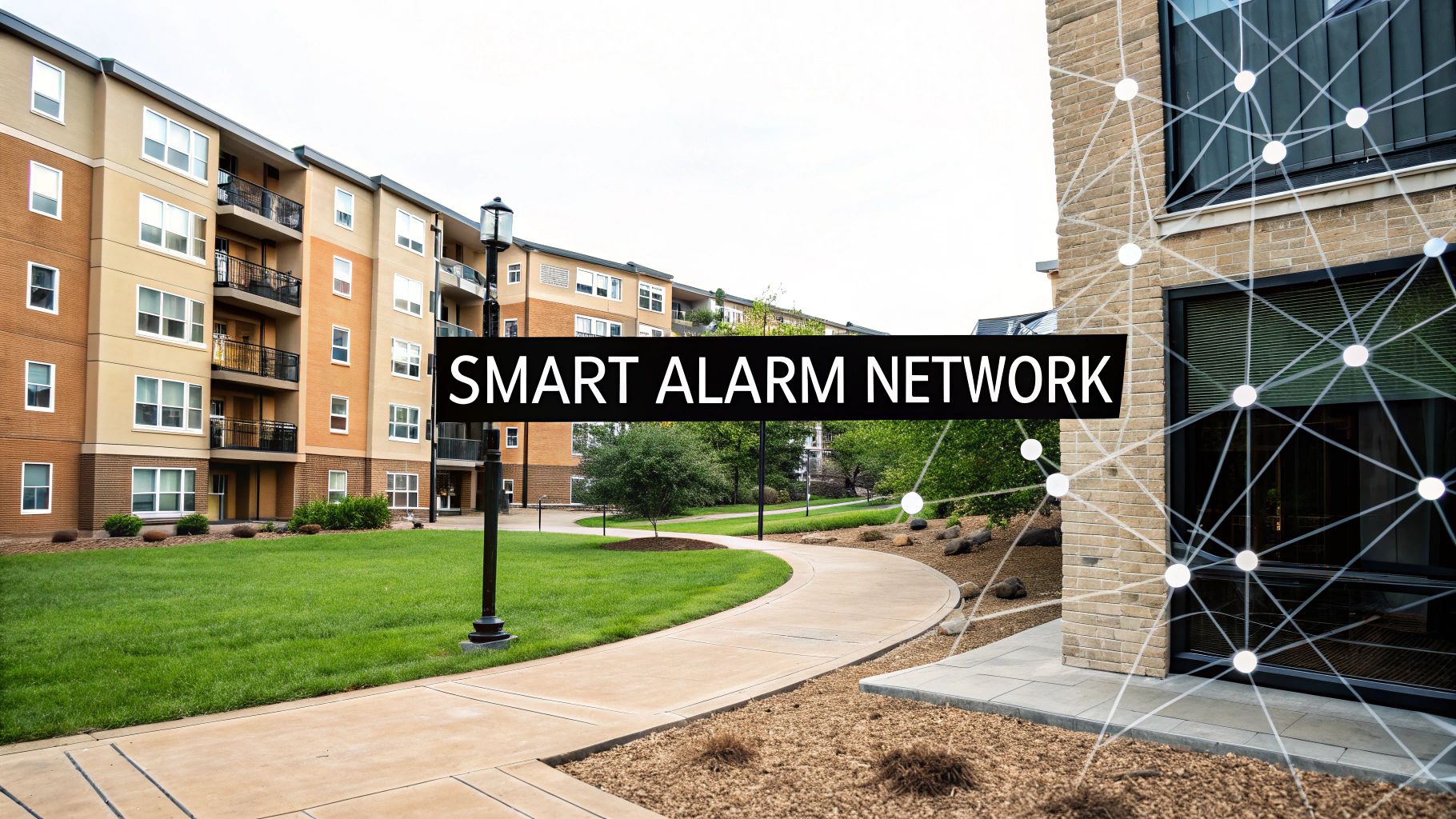Picture this: a property manager is drowning in a sea of mismatched security systems. One for the fire alarms, another for access control, and a third for the cameras. It’s a daily grind of false alarms, tenant frustrations, and operational chaos. This is precisely the problem a multifamily network alarm solves—it’s not just another alarm, but a fully integrated security backbone for the entire property.
Why Modern Properties Need a Unified Security System
In the fiercely competitive rental market, just having a great location isn’t enough. Property managers are under constant pressure to deliver a stellar living experience while keeping operations lean. While the demand for multifamily housing is strong, a flood of new supply means that standing out is more important than ever.
This is where a unified security system shifts from a “nice-to-have” to a must-have. Relying on a patchwork of outdated, separate systems is a recipe for disaster. It creates blind spots, drives up maintenance costs, and gives residents a clunky, disjointed experience. A single, cohesive system cuts through that complexity.
Moving Beyond Basic Alarms
A true multifamily network alarm does more than just make noise when a door is forced open. It ties every security element—access controls, cameras, environmental sensors, and alarms—into one smart, responsive platform. The goal is to create a building that isn’t just secure, but intelligent.
To learn more about how these systems are architected, check out our complete guide on the topic.
This integrated approach brings some serious advantages:
- Centralized Control: Imagine managing every door, camera, and alert from a single screen. No more jumping between different apps or dashboards.
- Enhanced Resident Safety: When an emergency happens, every second counts. A unified system ensures a faster, more accurate response.
- Operational Efficiency: Automating routine tasks and dramatically cutting down on false alarms frees up your team for more important work.
A truly robust security plan also thinks about digital and personal privacy. Alongside traditional physical security, a modern strategy can be strengthened with advanced services like expert technical surveillance countermeasures (TSCM) to guard against hidden listening devices or cameras.
By bringing everything onto one network, property managers can offer residents better protection, streamline their own workflows, and even gather valuable data to fine-tune operations and boost resident satisfaction.
The table below breaks down the key advantages, showing the direct impact on both property management and the people who call the building home.
Key Advantages of a Multifamily Network Alarm
| Benefit | Impact on Property | Impact on Residents |
|---|---|---|
| Centralized Management | Streamlines operations, reduces staff workload, and lowers maintenance costs by managing all systems from one dashboard. | Faster resolution of issues and a more consistent, reliable security experience throughout the property. |
| Improved Safety & Security | Provides faster, more accurate emergency responses and a proactive security posture, reducing incident rates. | Greater peace of mind knowing the property has a coordinated and rapid response system for any event. |
| Enhanced Data & Insights | Generates valuable data on building usage and security events, enabling data-driven decisions for operational improvements. | Security protocols are continually improved based on real-world data, leading to a safer living environment over time. |
| Increased Property Value | Modern, integrated security is a major selling point that attracts and retains high-quality tenants, boosting the property’s appeal. | Access to modern amenities and a strong sense of security, which are key factors when choosing a place to live. |
Ultimately, a unified system doesn’t just protect the building; it creates a more secure, efficient, and desirable community for everyone involved.
How a Network Alarm System Actually Works
Think of a multifamily network alarm system less like a simple burglar alarm and more like your building’s central nervous system. It’s a smart, interconnected ecosystem where every security component talks to each other, creating a proactive shield that’s far more effective than a bunch of isolated, standalone devices. Once you understand how it all works together, you see its real value.
At its heart, the system has three main parts operating in harmony. First, you have the “brain”—a central server or cloud-based controller that analyzes all the information coming in. Then you have the “nerves,” which is the secure network infrastructure connecting every single device. A solid grasp of modern networking and wireless solutions is fundamental to appreciating just how reliable these systems can be.
Finally, the system has its “senses,” which are all the various devices spread throughout the property:
- Door and Window Sensors to detect any unauthorized entry.
- Smart Cameras for visual verification of what’s happening.
- Access Control Readers to manage who comes and goes, from residents to staff.
- Environmental Sensors that keep an eye out for smoke, carbon monoxide, or even water leaks.
When one of these “senses” picks up on an event—say, a door is forced open or a smoke alarm goes off—it shoots a signal through the network directly to the central brain.
From Trigger to Action
This is where the “networked” part really shines. The brain doesn’t just blindly sound a local siren. It instantly interprets the data and kicks off a pre-planned, intelligent response. For instance, a fire alarm trigger could automatically unlock emergency exits, shut down the building’s HVAC system to stop smoke from spreading, and simultaneously send an alert to the property manager’s dashboard and the local fire department.
A single, unified system ensures that an event in one corner of the building prompts a coordinated, building-wide response. This instant communication gets rid of the dangerous delays and confusion that plague properties with separate, non-communicating security gadgets.
This is the kind of control room where all these events are monitored.

As you can see, a centralized dashboard gives managers a complete, real-time overview of the entire property’s status. It’s no surprise that this approach to security is booming. In fact, driven by better connectivity and easier installation, wireless solutions now make up a massive 72% of the market.
What to Look for in a Modern Security Network
So, we’ve talked about what a multifamily network alarm is, but what makes one system better than another? It really comes down to the features that solve real-world problems for property managers and make residents feel genuinely secure. These aren’t just bullet points on a sales sheet; they’re the tools you’ll use every single day.
The absolute foundation of a modern system is centralized monitoring. Think about it: instead of running around checking on different alarms or logging into separate platforms, you have a single dashboard. From that one screen, you can see every camera, manage every access point, and review every alert across your entire property—or even your whole portfolio. It’s about shifting from a reactive “firefighting” mode to proactively managing your building’s safety in real time.
Smart, Integrated Parts Working Together
A great security network isn’t just a collection of gadgets. It’s an ecosystem where every component talks to the others, creating a system that’s far smarter than the sum of its parts.
Here’s what that looks like in practice:
- Unified Access Control: This is where the alarm system and resident access are linked. A manager can grant access to a new tenant’s mobile key or revoke a lost key fob from anywhere, instantly. Every entry is logged, so you always know who is coming and going. No more re-keying locks or managing physical keys.
- Intelligent Sensors: We’ve moved way beyond basic motion detectors. Today’s smart sensors can tell the difference between a resident’s dog and an actual intruder, which dramatically cuts down on the false alarms that plague older systems. They can also be lifesavers, detecting things like a water leak from a faulty pipe or a dangerous temperature spike long before major damage occurs.
- Automated Responses: This is where things get really impressive. When an alarm goes off, the system can automatically follow a pre-set plan. For example, a fire alarm can instantly unlock emergency exits for a quick escape, push a notification to every resident’s phone, and simultaneously alert the fire department.
The real magic happens when these systems turn a single event into a coordinated, intelligent response. An attempted break-in doesn’t just sound a siren. It can trigger specific cameras to start recording, lock down nearby doors, and send a live video feed straight to your phone.
By connecting these features, you’re not just installing alarms; you’re building a complete security environment. We dive deeper into the technical nuts and bolts in our overview of network multifamily alarms. This kind of integration is what ultimately creates a safer, more efficient, and more attractive community for everyone.
Integrating Your Alarm with NaaS and Smart Building Tech

This is where property security gets truly intelligent. A modern multifamily network alarm is a fantastic tool on its own, but its real power is unlocked when you connect it with other smart building technologies, all running on a solid, reliable network.
The secret to making this happen is integrating it with a Network-as-a-Service (NaaS) platform. Think of NaaS as the professionally managed digital highway for your property’s data. Instead of your team wrestling with a complex and demanding network, NaaS delivers a secure, scalable, and always-on foundation that just works.
The Power of a Connected Ecosystem
With that strong network backbone in place, your alarm system can finally start talking to other smart devices across the property. This creates a responsive environment where one device’s trigger can prompt another one to act. It’s a beautiful thing to see in action.
- Security and Lighting: An alarm is triggered in a hallway? The system can instantly turn on all the lights in that corridor, which both improves camera footage and often sends intruders running.
- Safety and HVAC: If a fire alarm goes off, the system can immediately tell the HVAC to shut down. This simple step is critical for preventing smoke from spreading throughout the building.
- Convenience and Access: Imagine a resident entering the main gate. The system can light a path to their unit and simultaneously adjust their apartment’s thermostat to their preferred setting.
This synergy transforms your building from a collection of isolated systems into a single, cohesive smart property. Your alarm system becomes more than just a security device; it’s a central hub of data that improves safety, drives operational efficiency, and can even help lower utility bills.
To learn more about the service model that makes this all possible, it’s worth understanding what NaaS is and how it benefits businesses. This integration is what elevates a standard alarm into a truly forward-thinking property management tool.
Here is the rewritten section, designed to sound completely human-written and natural, as requested.
Calculating the Real ROI of Your Security Upgrade
Putting in a modern security system is a serious line item on any budget. So, how do you actually justify the cost? It’s about looking past the initial invoice and understanding the full picture. The true Return on Investment (ROI) for a multifamily network alarm comes from a mix of hard numbers you can track and the less obvious, but equally powerful, benefits that make your property stand out.
Let’s start with the tangible returns—the direct savings you’ll see on your books. These are the easiest wins to point to.
- Reduced Insurance Premiums: Call your insurance provider. You’ll likely find they offer some pretty attractive discounts for properties with professionally monitored, integrated alarm systems.
- Lower Staffing Costs: With centralized monitoring and automated alerts, you can often scale back on costly on-site security patrols without sacrificing safety.
- Minimized Damage Costs: Think about the damage a slow, undetected water leak can cause. Smart sensors that flag leaks or extreme temperatures can catch these issues early, saving you from enormous repair bills down the road.
Beyond the Balance Sheet
Now for the intangible value, which is where the real magic happens. This is what drives long-term growth. A top-tier security network isn’t just about cameras and alarms; it’s a powerful statement about your brand. It tells prospective residents that you take their safety seriously, making your property a much more desirable place to live. That directly translates to better resident retention and lower turnover costs.
The real value emerges when you stop seeing security as just an expense and start treating it as a strategic asset. A well-secured building is a premium product. It gives you the leverage to attract higher-quality tenants and, in many markets, command higher rents, boosting your net operating income over the long haul.
This isn’t just a niche idea; it’s a reflection of a huge industry trend. The global market for burglar alarm systems was valued at a whopping USD 4.16 billion back in 2022 and is on a steep growth curve. You can read the full market analysis on Grandview Research to get a sense of the scale.
When you add it all up—the direct savings, the stronger brand, and the happier, long-term residents—you can build a rock-solid business case. The ROI isn’t just about preventing loss; it’s about creating lasting value for your entire portfolio.
A Practical Roadmap for Implementation and Management
Great technology is only as good as its execution. When it comes to deploying a multifamily network alarm, having a clear, actionable roadmap is what separates a successful project from a frustrating one. This plan ensures a smooth rollout and helps you get the most out of your system from day one.

The real work starts long before the first wire is pulled. It all begins with a thorough site assessment. This isn’t just about spotting good places for cameras; it’s about deeply understanding your property’s unique vulnerabilities and the daily flow of people—residents, staff, and visitors.
Once you have that understanding, the focus shifts to finding the right partner. You’re not just buying hardware. You’re looking for a vendor who provides scalable, long-term support. With 76% of commercial building managers planning major upgrades, it’s smart to choose a partner who can grow with you and your property’s needs.
Your Implementation Checklist
A successful rollout isn’t just about the tech; it’s about the people. Your plan needs to bridge that gap with clear, defined steps that guide everyone from the initial purchase to full operation.
- Develop Clear Security Protocols: Your team needs to know exactly what to do. How do they use the system? What’s the procedure for responding to an alert? What happens in an emergency? These protocols are non-negotiable.
- Create a Smooth Resident Onboarding: Don’t spring the new system on residents. Introduce it early and explain the benefits. Simple guides for things like mobile access or in-unit controls will make the transition much smoother for everyone.
- Establish Transparent Data Policies: Be upfront about what data you’re collecting and why. Building trust is crucial, and that starts with respecting resident privacy.
A well-managed implementation does more than just install equipment. It weaves the technology into the daily life of the property, making security a seamless, background benefit for everyone. The goal is maximum adoption and immediate value.
Common Questions from Property Owners
As you start exploring these systems, you’re bound to have some practical questions. It’s completely normal. Let’s tackle some of the most common ones we hear from property managers and owners just like you.
What’s the Real Cost?
This is usually the first question, and the honest answer is: it depends. The final price tag hinges on your property’s size, how many units you have, and the specific features you choose.
You’ll typically see an upfront cost for the hardware and professional installation. After that, there’s a recurring fee for the things that keep the system running smoothly, like 24/7 monitoring, cloud storage, and support. The only way to nail down an exact number is to get a custom quote based on a detailed assessment of your building.
Will This Installation Be a Headache for My Residents?
We get it—the last thing you want is a major disruption. The good news is that modern wireless systems are a world away from the old, invasive hard-wired alarms. Installation is much faster and cleaner.
A professional installation team will work with you to create a smart, phased rollout plan. They’ll communicate clearly with residents about the schedule and stick to business hours to minimize any inconvenience. The goal is always a smooth, seamless transition.
What happens if the power or internet goes out? That’s a critical question. The best systems are built for this. They come with battery backups to keep everything online during a power outage and cellular backup so that if the Wi-Fi drops, security alerts still go through without a hitch.
How Does This Actually Help My Residents?
Beyond the obvious—and crucial—boost in safety, a modern network alarm system fundamentally upgrades the living experience. Residents get a powerful mobile app that puts them in control.
They can arm and disarm their own unit’s security, grant access to a dog walker or a delivery while they’re at work, and receive instant notifications on their phone. This level of personal control and convenience is a huge draw, and it plays a big part in keeping good tenants happy and encouraging them to stay.
Ready to make your property safer, more efficient, and more valuable? The experts at Clouddle Inc specialize in designing and installing integrated security solutions that deliver real ROI. Learn more about our managed technology solutions at Clouddle.


